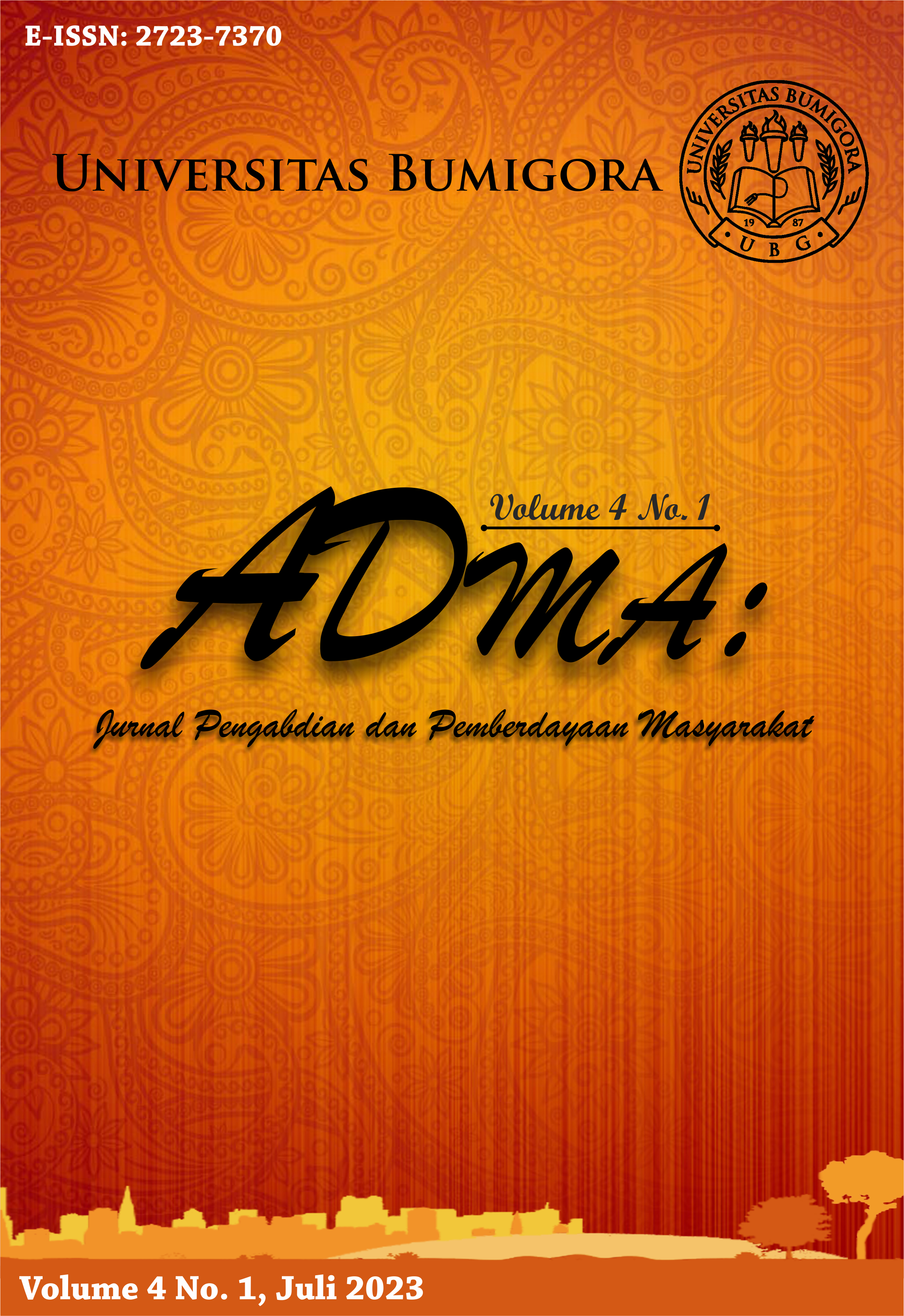Pendidikan Kesehatan tentang Penatalaksanaan Non Farmakologi untuk Mengurangi Nyeri Persalinan
Abstract
Labor is the process of expulsion of the fetus that occurs in full-term pregnancies born spontaneously with a rear-head presentation without complications to the mother and fetus. During childbirth, the mother feels pain that can interfere with comfort during contractions. Labor pain appears during the first stage of the active phase. Methods to reduce pain due to labor can be done with pharmacological and non-pharmacological methods. Non-pharmacological will not give side effects to the mother. Non-pharmacological techniques are usually deep breathing relaxation techniques, warm/cold compresses, music therapy, aromatherapy, and massage. Objective: to increase the knowledge of pregnant women about non-pharmacological management to reduce labor pain. Methods: counseling, discussion, question, and answer, as well as pretest and posttest. Result: there is an increase in knowledge of pregnant women who have good knowledge by 29,1%, namely from 62,5% increased to 91,6%. Conclusion: there is an increase in the knowledge of pregnant women about non-pharmacological management to reduce labor pain after receiving health education.
References
Asrinah. (2010). Asuhan Kebidanan Masa Persalinan. Graha Ilmu.
Bobak, Lowdwermilk, & Jasen. (2015). Buku Ajar Keperawatan Maternitas. EGC.
Bulahari, S., Korah, H., & Lontaan, A. (2015). Faktor-Faktor yang Mempengaruhi Pengetahuan Remaja tentang Kesehatan Reproduksi. Jurnal Ilmiah Bidan, 3(2).
Fauziah, A. N., Siti, M., & Sulistyorini, E. (2017). Penggunaan Leaflet Terhadap Peningkatan Pengetahuan Tentang Pemeriksaan Payudara Sendiri. GASTER, 15(2), 204–213.
Hadaina, W. (2017). Pengaruh Pendidikan Kesehatan Terhadap Pengetahuan Ibu Hamil Tentang Anemia.
Juniartati, E. (2018). Penerapan Counter Pressure Untuk Mengurangi sakit Persalinan Kala Satu. Jurnal Kebidanan.
Kacperczyk-Bartnik, J., Bartnik, P., Symonides, A., Sroka-Ostrowska, N., Dobrowolska-Redo, A., & Romejko-Wolniewicz, E. (2019). Association between antenatal classes attendance and perceived fear and pain during labour. Taiwanese Journal of Obstetrics and Gynecology, 58(4), 492–496.
Kristina. (2016). Efek Metode Pijat melawan sakit Persalinan pada ibu Inpartu Kala saya fase aktif di Klinik bersalin Anna Medan tahun 2016. Jurnal Kebidanan.
Linggardini, K., & Aprilina, H. . (2016). Pengaruh pendidikan kesehatan pada ibu hamil terhadap pengetahuan tentang preeklamsia di wilayah kerja puskesmas Sokaraja I. Medisains Ilmu-Ilmu Kesehatan, 14(3).
Murray, M. L., & Huelsmann, G. M. (2013). Persalinan dan Melahirkan : Praktik Berbasis Bukti. EGC.
Notoatmodjo, S. (2012). Promosi Kesehatan & Ilmu Perilaku. Rineka Cipta.
Potter, A., & Perry, A. G. (2015). Buku Ajar Fundamental Keperawatan: Konsep, Proses, Dan Praktik (4th ed.). EGC.
Rahayu, A. N. (2020). Efektivitas Music Therapy terhadap Pengurangan Nyeri Persalinan. Jurnal Kesehatan Vokasional, 5(2), 83–94.
Rahayu, P. P., & Febriati, L. D. (2020). Pelatihan Tekhnik Pengurangan Rasa Nyeri Persalinan Pada Ibu Hamil Dengan Metode Terapi Komplementer Di PMB Istri Yuliani Ngaglik Sleman D.I Yogyakarta. Jurnal Pengabdian Dharma Bakti, 3(1), 44.
Reeder, S. J., Leonide, L. M., & Deborah, K. G. (2014). Keperawatan Maternitas: Kesehatan Wanita, Bayi & Keluarga Ed. 18, Vol. 1. EGC.
Rilyani. (2017). Hubungan Pendampingan Suami Dengan Tingkat Kecemasan Ibu Bersalin (Kala I) Di Ruang Bersalin Rumah Sakit Pertamina Bintang Amin. Jurnal Kesehatan Holistik (The Journal Of Holistic Healthcare), 11(3), 188–195.
Rukiyah, A. Y. (2012). Asuhan Kebidanan I (Kehamilan Cetakan Pertama). Trans Info Media.
Sabatini, K., & Inayah, T. (2012). Determinan Komplikasi Persalinan pada Ibu Pernah Menikah usia 15-49 Tahun di Provinsi Banten Tahun 2007.
Sari, D. P., Rufaida, Z., & Lestari, S. W. P. (2018). Nyeri persalinan. In E. D. Kartiningrum (Ed.),. In Buku Ajar.
Setyorini, R. H. (2013). Belajar Tentang Persalinan (Pertama). Graha Ilmu.
WHO. (2018). Maternal Mortality. World Health Organization.

This work is licensed under a Creative Commons Attribution-ShareAlike 4.0 International License.











